The Labroidei suborder of the Perciformes order comprises about 2,300 species, which are united into six families. Most multicolored fish, which can be found almost underfoot at the Mediterranean shore, are representatives of this particular suborder.

(Cuckoo wrasse. Drawing by an unknown author, 1836. etsy.com)
Most people consider Labroidei to be small inshore fish. But it is not the case. Humphead wrasse (Cheilinus undulatus), a fish of the wrasses (Labridae) family, can be 230 centimeters long and weigh more than 190 kilograms. Humphead wrasse prefers to swim close to the coral reefs of the Red Sea and the tropical regions of the Indian and Pacific Oceans.

(Humphead wrasse. Photo © lotour.com)
Over half of the Labroidei suborder species are inhabitants of fresh waters, which belong to the Cichlidae family and are well known to aquaristics enthusiasts. Other species inhabit sea and, rarely, brackish water. Most species are characterized by protogyny hermaphroditism, that is, an age-related change of sex from female to male.
20 species of 3 families are found in the Adriatic Sea.
The wrasses (Labridae) family comprises about 550 fish species of 71 genera. They are only sea inhabitants. They inhabit inshore waters and coral reefs of the seas of the Atlantic, Indian and Pacific Ocean basins. The size, body shape and color of fish are very diverse. Most representatives chase bottom invertebrates; some medium-sized species are “cleaners” that remove ectoparasites from larger fish. On the average, representatives of Labridae are less than 15 centimeters long. However, fish of the Cheilinus genus, inhabiting the Indian and Pacific Oceans, are rather large. The largest representative is still the same humphead wrasse (Cheilinus undulatus). The following 18 representatives of the family are found in the Adriatic Sea:
Scale–rayed wrasse (Acantholabrus palloni).
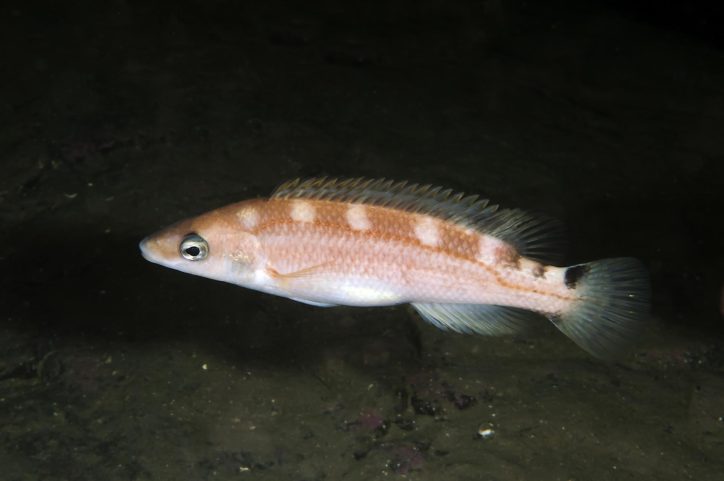
(Scale-rayed wrasse. Photo by © Erling Svensen. artsdatabanken.no)
It inhabits the depth of 30-500 meters. It is an inshore species, which prefers to swim close to a rocky and sandy bottom. The maximum recorded length is 25 cm. It feeds on bottom invertebrates. It is a permanent inhabitant of the Adriatic Sea.
Mediterranean rainbow wrasse (Coris julis).
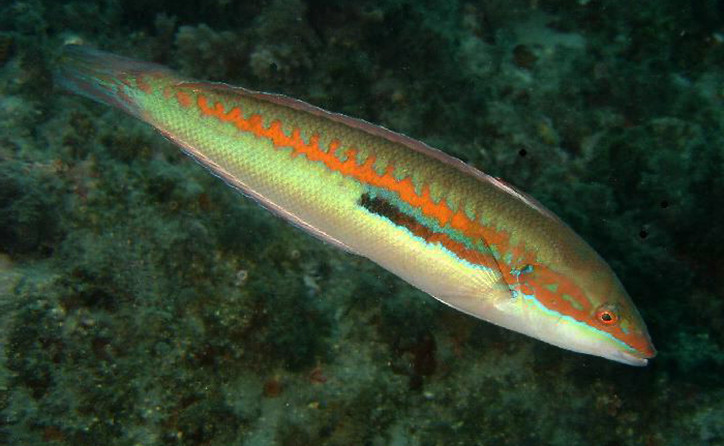
(Mediterranean rainbow wrasse male. Photo © blog.mallorcahiking.com)
It inhabits the depths of up to 120 meters, usually 1-60 meters. It prefers to swim close to a rocky bottom and in the meadows of sea grass or eelgrass. The maximum recorded length is 30 cm; specimens up to 20 cm long are more common. Males are brighter than females. At night, it gets scared and digs itself into the sand. It feeds mainly on small gastropods, sea urchins and worms. It is a permanent inhabitant of the Adriatic Sea.
Goldsinny wrasse (Ctenolabrus rupestris).
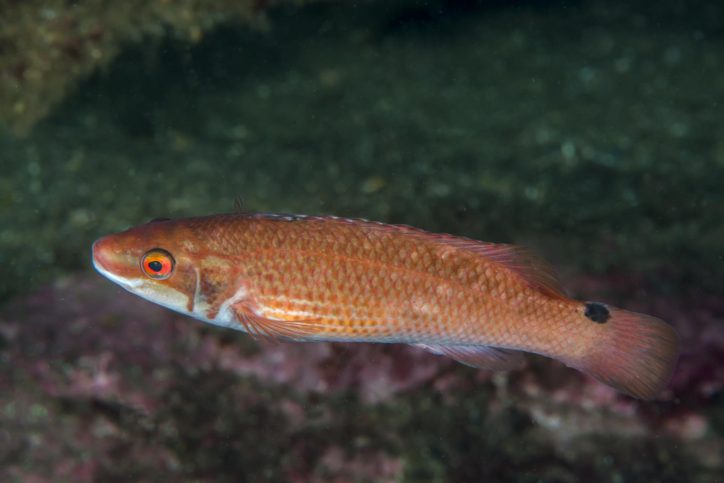
(Goldsinny wrasse. Photo by © Erling Svensen. artsdatabanken.no)
It inhabits the depth of 1-50 meters, usually 1-20 meters. It prefers to swim close to a rocky bottom covered with algae. The maximum recorded length is 18 cm; specimens up to 11 cm long are more common. It feeds on bryozoans, crustaceans and gastropods. It is a permanent inhabitant of the Adriatic Sea.
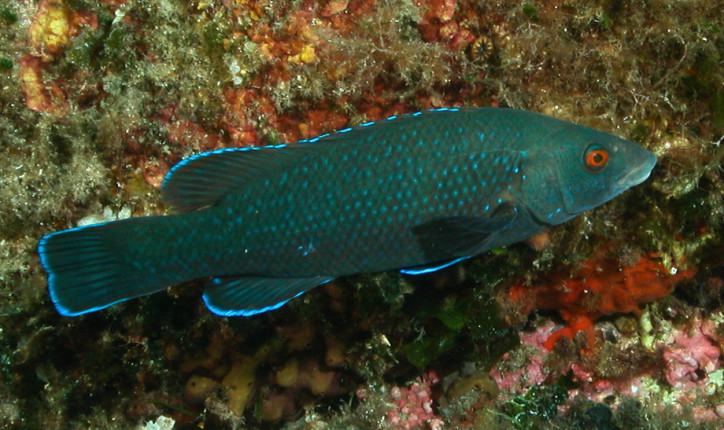
(Brown wrasse. Photo by © Protesilao. naturamediterraneo.com)
It inhabits the depth of 1-50 meters. It prefers to swim close to a rocky bottom among algae. The maximum recorded length is 45 cm; specimens up to 40 cm long are more common. Medium-sized specimens may form small schools. It feeds on sea urchins, mollusks, crabs and worms. It is a permanent rare inhabitant of the Adriatic Sea.
Cuckoo wrasse (Labrus mixtus).
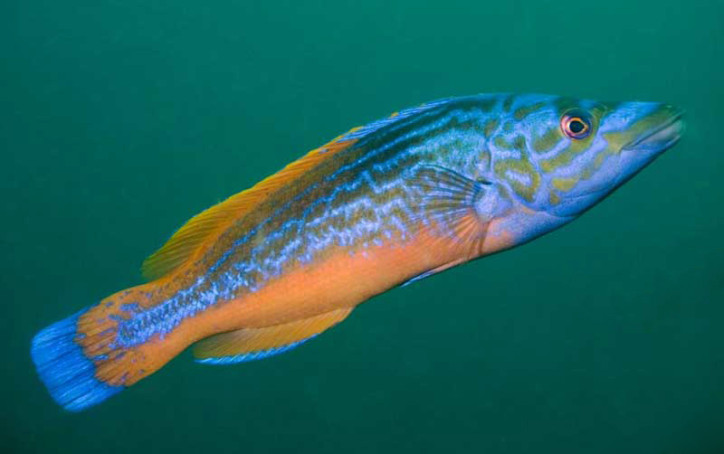
(Cuckoo wrasse male. Photo by © Sue Daly. marlin.ac.uk)
It inhabits the depth of 2-200 meters, usually 40-80 meters. It prefers to swim close to a rocky bottom and in algae thickets. Males are brighter than females. The maximum recorded length is 40 cm, specimens up to 30 cm long are more common. It feeds on crustaceans, fish and mollusks. It is a permanent inhabitant of the Adriatic Sea.
Green wrasse (Labrus viridis).
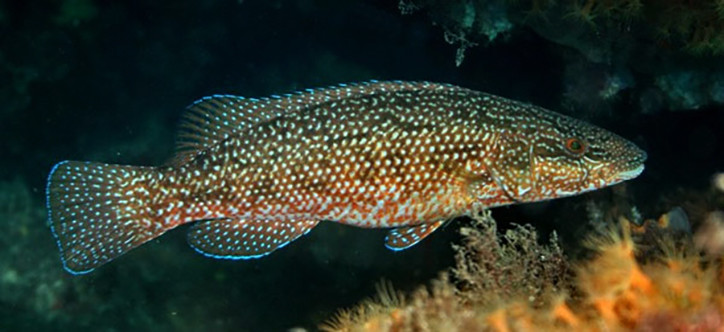
(Green wrasse. Photo © bqqo.com)
It prefers to swim in the coastal area at the depth of 1-50 meters close to a rocky bottom in eelgrass or sea grass thickets. The maximum recorded length is 47 cm; specimens up to 37 cm long are more common. It feeds on crustaceans, fish and mollusks. It is a permanent rare inhabitant of the Adriatic Sea, which is more often found in its southern part. It is registered in the IUCN Red List as a vulnerable species (VU).
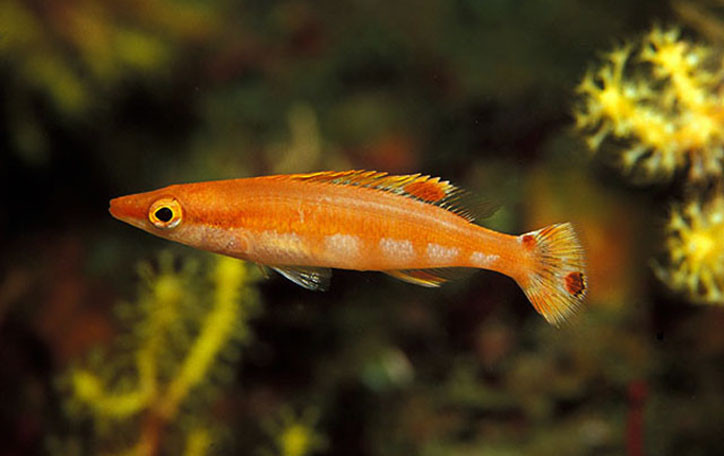
(Lappanella fasciata. Photo by © Borut Furlan. fishbase.org)
It inhabits the depth of 35-200 meters. It prefers to swim close to a rocky bottom. The maximum recorded length is 15 cm. It feeds on crabs, gastropods and polychaetes. It was found several times in the Adriatic Sea.
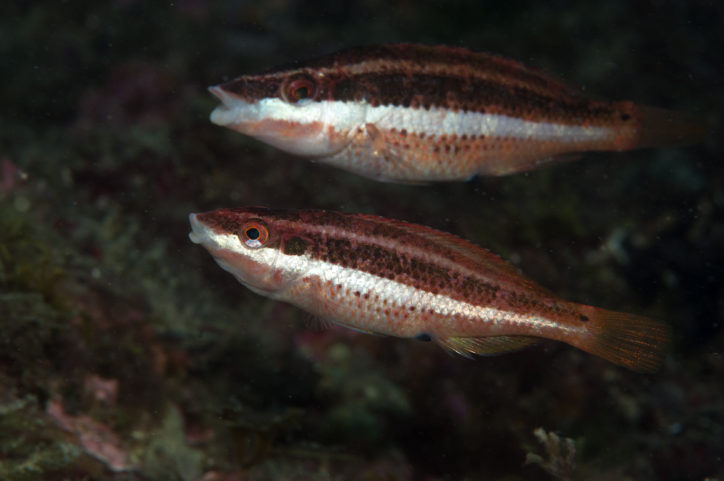
(Symphodus doderleini. Photo © ilpianetazzurro.it)
It inhabits the depth of 2-40 meters. It prefers to swim in sea grass thickets. The maximum recorded length is 10 cm. It feeds on worms, bryozoans, small mollusks. It is a permanent inhabitant of the Adriatic Sea.

(Symphodus melanocercus. Photo by © Jordi Regàs. cibsub.cat)
It inhabits the depth of 1-25 meters. It prefers to swim close to a rocky bottom covered with grass. The maximum recorded length is 14 cm; specimens up to 11 cm long are more common. It feeds on worms, crustaceans, and bryozoans. It is a fish-cleaner, eating ectoparasites from the scales of larger fish of other species. It is a permanent rare inhabitant of the Adriatic Sea.
Axillary wrasse (Symphodus mediterraneus).
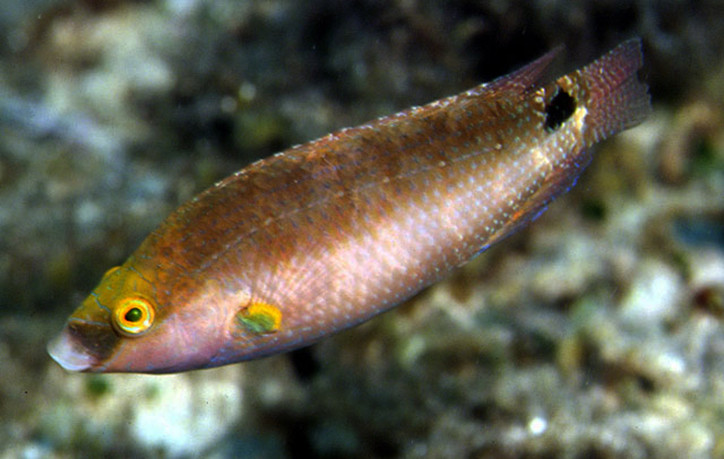
(Axillary wrasse. Photo by © Robert A. Patzner. fishbase.org)
It inhabits the depth of 1-50 meters. It prefers to swim close to the bottom in sea grass thickets. The maximum recorded length is 18 cm; specimens up to 12 cm long are more common. It feeds on mollusks, worms, sea urchins and bryozoans. It is a permanent inhabitant of the Adriatic Sea.
Corkwing wrasse (Symphodus melops).
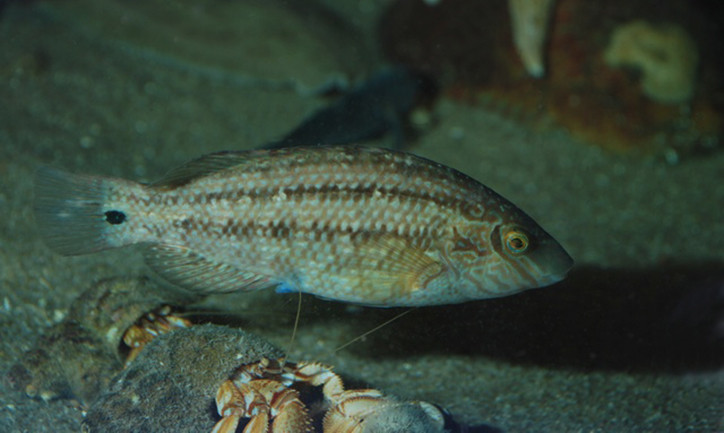
(Corkwing wrasse female. Photo by © JC Schou. biopix.dk)
It inhabits the depth of 1-30 meters. It prefers to swim in the coastal area close to a rocky bottom covered with sea grass, and enters lagoons. The maximum recorded length is 28 cm; specimens up to 20 cm long are more common. Males are brighter than females. It feeds on mollusks, bryozoans, worms and crustaceans. It is a permanent rare inhabitant of the Adriatic Sea.
Ocellated wrasse (Symphodus ocellatus).

(Ocellated wrasse male. Photo by © Dalibor Andres. wildcroatia.net)
It inhabits the depth of 1-30 meters. It prefers to swim in the coastal area close to a rocky bottom covered with sea grass. The maximum recorded length is 12 cm. Males are brighter than females. It feeds on bryozoans, worms, shrimps, amphipods. It is a permanent inhabitant of the Adriatic Sea.
Grey wrasse (Symphodus cinereus).

(Grey wrasse. Photo by © Rick Stuart-Smith. reeflifesurvey.com)
It inhabits the depth of 1-30 meters. It prefers to swim in the coastal area in sea grass thickets close to the bottom. It is often found in lagoons and estuaries with a large amount of vegetation. The maximum recorded length is 16 cm, usually up to 8 cm. It feeds on shrimps, amphipods, bivalves. It is a permanent inhabitant of the Adriatic Sea.
Five–spotted wrasse (Symphodus roissali).
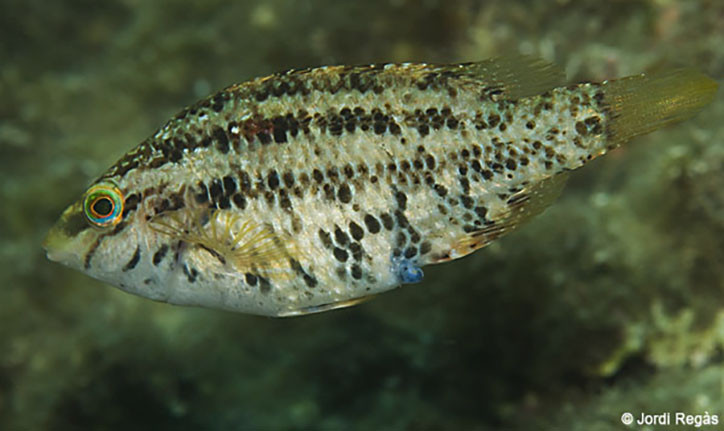
(Five-spotted wrasse. Photo by © Jordi Regàs. cibsub.cat)
It inhabits the depth of 1-30 meters. It prefers to swim close to a rocky bottom in sea grass thickets. The maximum recorded length is 17 cm, specimens up to 12 cm long are more common. It feeds on mollusks, shrimps, sea urchins. It is a permanent inhabitant of the Adriatic Sea.
Pointed–snout wrasse (Symphodus rostratus).
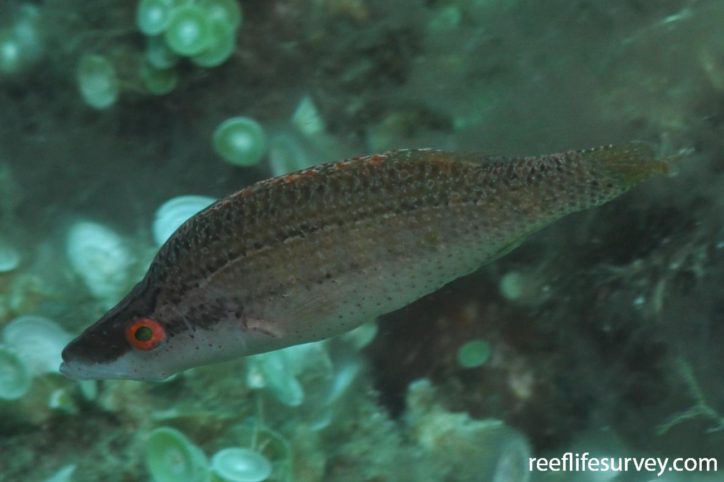
(Pointed-snout wrasse. Photo by © Rick Stuart-Smith. reeflifesurvey.com)
It inhabits the depth of 1-50 meters. It prefers to swim close to a rocky bottom in sea grass thickets. The maximum recorded length is 13 cm. It feeds on crustaceans. It is a permanent rare inhabitant of the Adriatic Sea.
East Atlantic peacock wrasse (Symphodus tinca).
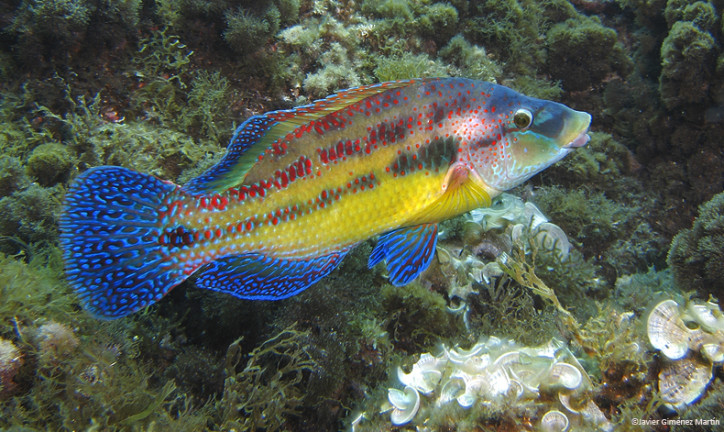
(East Atlantic peacock wrasse male. Photo by © Giménez Martín. fotodenaturaleza.com)
It inhabits the depth of 1-50 meters. It prefers to swim close to a rocky bottom in sea grass thickets. It often enters bays and lagoons. Males are brighter than females. The maximum recorded length is 44 cm; specimens up to 25 cm long are more common. It feeds mainly on sea urchins, mollusks, shrimps, and crabs. It is a permanent inhabitant of the Adriatic Sea.
Ornate wrasse (Thalassoma pavo).
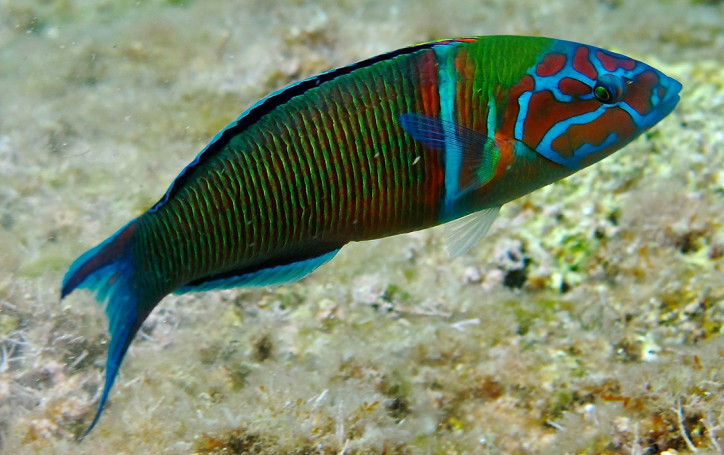
(Ornate wrasse. Photo by © Simon Brandl. scimonopsis.com)
It inhabits the depth of 1-150 meters, usually 1-50 meters. It prefers to swim close to a rocky bottom in sea grass thickets. The maximum recorded length is 25 cm; specimens up to 20 cm long are more common. It feeds on small mollusks and crustaceans. It is a permanent inhabitant of the Adriatic Sea.
Pearly razorfish (Xyrichtys novacula).
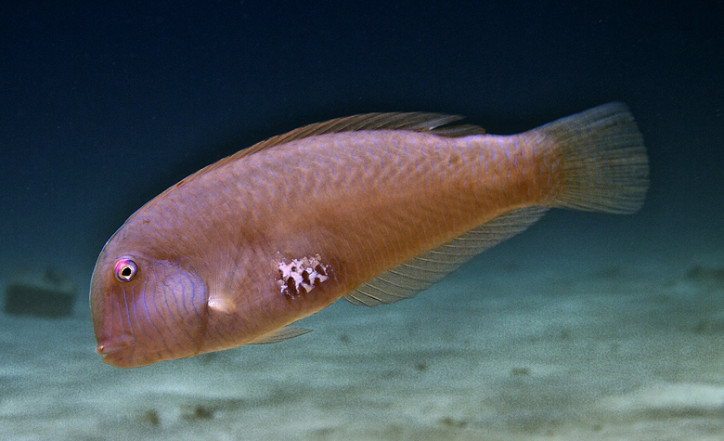
(Pearly razorfish. Photo © tokaiki.net)
It inhabits the depth of 1-90 meters. It prefers to swim close to a sandy bottom close to algae thickets. The maximum recorded length is 38 cm; specimens up to 20 cm long are more common. It feeds on mollusks, crabs and shrimps. It is a permanent rare inhabitant of the Adriatic Sea.
The Pomacentridae family comprises more than 400 fish species of 29 genera. They inhabit all tropical seas and are most widely represented in the Indo-Pacific region. Most species inhabit shallows 2 to 15 meters deep, coral reefs, and feed on algae, plankton and small bottom crustaceans. Fish are of various and often bright colors. One representative of the family of the Chromis genus is found in the Adriatic Sea:
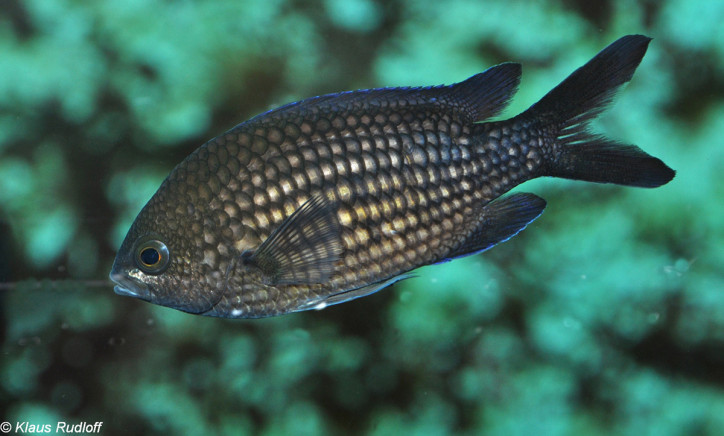
(Damselfish. Photo by © Klaus Rudloff. biolib.cz)
It inhabits the depth of 2-40 meters. It is a schooling fish. It prefers to swim in the water column above a rocky bottom and thickets of vegetation. The maximum recorded length is 25 cm, specimens up to 13 cm long are more common. It feeds on zooplankton and small invertebrates. It is a permanent inhabitant of the Adriatic Sea.
The parrotfishes (Scaridae) family comprises 100 fish species of 10 genera. They inhabit the Atlantic, Indian and Pacific Oceans and the seas of their basins. The fish got its name due to the densely growing teeth. As a result, the jaws of the fish resemble a beak of a parrot. Using the “beak”, Scaridae scrape algae from corals and stone surfaces, crushing both stones and corals. It makes Scaridae one of the most important “producers” of sand on coral reefs. Many species are brightly colored. Most Scaridae can be up to 30-50 centimeters long, the largest fish of the family is Bolbometopon muricatum, which inhabits the Indian and Pacific Oceans. It can be 130 centimeters long and weigh 46 kilograms. One representative of the family of the Sparisoma genus is found in the Adriatic Sea:
Parrotfish (Sparisoma cretense).

(Parrotfish female. Photo by © Sacha Lobenstein. enelmar.es)
It inhabits the depth of 1-50 meters. It prefers to swim close to a rocky bottom. Females are brighter than males. The maximum recorded length is 50 cm, specimens up to 30 cm long are more common. It feeds on algae and small invertebrates. It is a permanent inhabitant of the Adriatic Sea, which is more often found in its southern part.
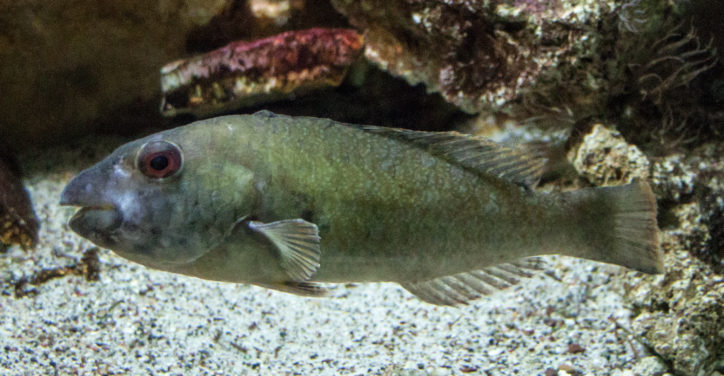
(Parrotfish male. Photo by © Szilas. en.wikipedia.org)